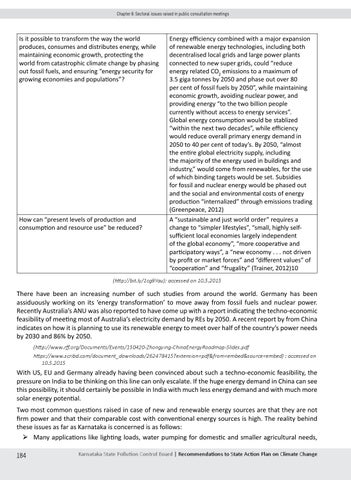Chapter 8: Sectoral issues raised in public consultation meetings
Is it possible to transform the way the world produces, consumes and distributes energy, while maintaining economic growth, protecting the world from catastrophic climate change by phasing out fossil fuels, and ensuring “energy security for growing economies and populations”?
How can “present levels of production and consumption and resource use” be reduced?
Energy efficiency combined with a major expansion of renewable energy technologies, including both decentralised local grids and large power plants connected to new super grids, could “reduce energy related CO2 emissions to a maximum of 3.5 giga tonnes by 2050 and phase out over 80 per cent of fossil fuels by 2050”, while maintaining economic growth, avoiding nuclear power, and providing energy “to the two billion people currently without access to energy services”. Global energy consumption would be stablized “within the next two decades”, while efficiency would reduce overall primary energy demand in 2050 to 40 per cent of today’s. By 2050, “almost the entire global electricity supply, including the majority of the energy used in buildings and industry,” would come from renewables, for the use of which binding targets would be set. Subsidies for fossil and nuclear energy would be phased out and the social and environmental costs of energy production “internalized” through emissions trading (Greenpeace, 2012) A “sustainable and just world order” requires a change to “simpler lifestyles”, “small, highly selfsufficient local economies largely independent of the global economy”, “more cooperative and participatory ways”, a “new economy . . . not driven by profit or market forces” and “different values” of “cooperation” and “frugality” (Trainer, 2012)10
(http://bit.ly/1cg9Yau); accessed on 10.5.2015
There have been an increasing number of such studies from around the world. Germany has been assiduously working on its ‘energy transformation’ to move away from fossil fuels and nuclear power. Recently Australia’s ANU was also reported to have come up with a report indicating the techno-economic feasibility of meeting most of Australia’s electricity demand by REs by 2050. A recent report by from China indicates on how it is planning to use its renewable energy to meet over half of the country’s power needs by 2030 and 86% by 2050. (http://www.rff.org/Documents/Events/150420-Zhongying-ChinaEnergyRoadmap-Slides.pdf https://www.scribd.com/document_downloads/262478415?extension=pdf&from=embed&source=embed) : accessed on 10.5.2015
With US, EU and Germany already having been convinced about such a techno-economic feasibility, the pressure on India to be thinking on this line can only escalate. If the huge energy demand in China can see this possibility, it should certainly be possible in India with much less energy demand and with much more solar energy potential. Two most common questions raised in case of new and renewable energy sources are that they are not firm power and that their comparable cost with conventional energy sources is high. The reality behind these issues as far as Karnataka is concerned is as follows: Many applications like lighting loads, water pumping for domestic and smaller agricultural needs, 184
Karnataka State Pollution Control Board | Recommendations to State Action Plan on Climate Change
